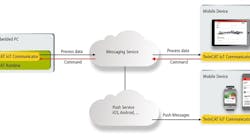Flextronics is a global sketch-to-scale company with more than 100 sites in 30 countries, providing ideation, manufacturing, assembly and logistics. Its 200,000 employees, 2,500 of them engineers, manufacture connected products for a connected world, explains Ofer Ricklis, vice president of global automation at Flex.
“Flex decided to explore and to deploy the connected factory strategy about two years ago,” explains Ricklis. “This was part of several efforts under the IIoT/Industry 4.0 initiatives which we ran with key customers. About a year ago, we refined our strategy and, from the manufacturing automation perspective, we defined our automation building blocks, which includes the hardware and software solutions enabling the fog-computing approach, among others. We are already deploying our systems, which are connected to both our internal factory and shop-floor management systems and to other software platforms. These systems are running in our sites in the United States, Mexico, India, Israel and Europe. Our plan is to have flex sites fully connected and managed by our Smart software platforms by 2020.”
OEMs have different needs than end users, explains Daymon Thompson, automation specialist, North America, at Beckhoff Automation. “It depends on your use case,” he says. “What are the business goals that apply to IoT and Industry 4.0 implementation in your manufacturing or OEM operations?”
The corporate goals of end customers are to reduce production costs, increase product quality and improve the efficiency of production quantity. Machine builder corporate goals, on the other hand, are to reduce machine costs, optimize smart machines, make machine maintenance more efficient, increase competitiveness and develop new business models.
In the fog
A fog-computing strategy provides decentralized computing by bringing the intelligence of the cloud closer to the end devices. It is one of many options that machine builders and factories can consider. A central server requires high costs for hardware and software, and cloud-computing services offer new possibilities and connectivity options. Local data processing captures more process data but requires data transport, exchange, storage, analysis and security; however, it reduces data traffic. The fog stack gets data from sensors to the machine controller, but you can’t do analytics locally.
“But what if we could take the analytics and put them into PLC code? Many automation controllers are quite powerful, even offering quad-core Intel Core i7 processors. This provides more than enough capability to do all the processing on the machine,” says Thompson. “Local condition monitoring has been around for many years, and the model of having processing power on the machine enables the user to bring in and analyze temperature, acoustics, vibration, voltage or current data. Combining this with IIoT and doing data analysis locally enables threshold monitoring of digital and analog values, timing analysis, lifecycle monitoring, RMS calculation, state analysis and energy calculation.”
Previously, a server-client model needed a VPN connection to tunnel back to the PLC or device in an end user facility, explains Thompson. “Now, we can use a message broker, and the outside devices don’t touch the internal device,” he says. “It could even be on a cloud server. The device can publish to the broker, and it doesn’t care about the end device.”
Whether you’re using a public cloud service, such as Azure or your own private cloud, you can use an IIoT protocol for communication. “If you have a legacy system or third-party device, you can pull data from it in its native language and convert to an IIoT protocol, such as MQTT, AMQP or OPC-UA,” suggests Thompson. “From a machine builder’s perspective, you want to know the varying differences in time between states of the machine. These analytics calculations can run in real-time without another platform. If you don’t want the data to leave your enterprise, you can use a message broker in your enterprise network or private cloud, which can include logging to a database and analytics platform, or you can use a public cloud. This enables the machine builder to access the data and analytics, as well. The infrastructure depends on the application, whose side you’re looking from and the business goals.”
From scope to technology selection
As a machine builder, Flex, for example, started with scale and global infrastructure. “Then we added scope,” explains Ricklis. “Then we added speed for real-time information about the market and about our business. It gives us real-time, end-to-end visibility of our supply chain. This allows us to have cross-functional innovation.”
Flex created an interconnected, touchless assembly operation called the Smart Automation project. “We have hundreds of people involved from around the world,” says Ricklis. “Our main business goals are to standardize, to have machine-to-machine communication, to eliminate the human touches along the manufacturing and assembly processes, and to leverage and improve asset utilization. We are partnering with a lot of hardware and software partners to run these process lines.”
Figure 1. Whether you’re using a public cloud service or your own private cloud, you can use an IIoT protocol for communication.
(Source: Beckhoff)
Flex selected Beckhoff to provide the control and IIoT infrastructure (Figure 1). “Our Flex robotic cell is fully automated and fully connected,” explains Ricklis. “It can do pick-and-place, automated screwing and automated assembly by leveraging EtherCAT and Beckhoff Industrial PCs (IPCs). Flex Smart Automation gives us traceability, real-time control and predictive analytics. Real-time detection gives us opportunities to monitor, control and predict processes and then communicate with the supply chain if there’s a problem. Once the line runs hundreds or thousands of parts, it can also run analytics.”
The Flex robotic cell product family and related Smart accessories are using several hardware and software platforms, including industrial robots, motion drivers and additional tools such as automatic screwdrivers, glue dispensers, soldering systems and visual inspection software and hardware.
“Each subsystem in most cases has its own drivers and controls,” says Ricklis. “The Beckhoff IPC was selected to orchestrate the entire system and is connected through EtherCAT Industrial Ethernet and I/Os to the different controllers, drivers and sensors.”
Smart Automation gives Flex the real-time information it desires. “We understand why things are happening before we have information from sensors and predefined logic,” says Ricklis. “Our next step, which is right on the horizon, is to predict, with the goal of reducing the human touches, and allowing the machines to back-feed the information and corrections in the IPC or in the cloud. This allows us to create end-to-end or fully automated processes and technology.”
ALSO READ: The IoT starts with common and proper things
The strategy allows Flex to scale and standardize automation globally, having flexible solutions that can be easily reutilized for many applications in sites all over the world, explains Ricklis. “We gain faster deployment times and shortening of NPI processes,” he says. Flex is able to support its ‘sketch to scale’ strategy by designing automated manufacturing lines as part as the product development process.
“The data aggregation and analysis allows us to optimize our end-to-end processes and to improve our efficiencies and quality,” says Ricklis.
Mike Bacidore is the editor in chief for Control Design magazine. He is an award-winning columnist, earning a Gold Regional Award and a Silver National Award from the American Society of Business Publication Editors. Email him at [email protected].






